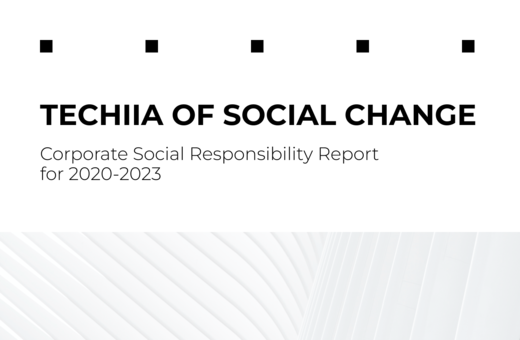
When done not under the pressure of creditors but based on one's convictions, restructuring cuts off all secondary aspects and allows focusing on what matters most, improving business efficiency.
On August 10, 2015, Larry Page the creation of Alphabet. This company consolidated all businesses related to information technology. The Google search engine and services based on it, YouTube, and the Pixel phones were grouped into a separate holding. Startups that were expected to take off in the future were separated. Larry Page and Sergey Brin became the CEO and President of the new company, respectively, and focused their efforts on its development.
At that time, the multi-vector concept of business development, such as the one held by Brin and Page before the creation of Alphabet, seemed to me the most viable. Therefore, my partner and I decided to open ourselves to multiple directions. Moreover, our previous business experience echoed one thing: diversify or die.
We organized professional esports events, built IT infrastructure projects, designed premium merchandise, developed software, and explored new directions. I was surprised to hear the news about the restructuring of Google back then.
However, today, as the number of business directions in our holding has reached a dozen and a half, I often recall the Alphabet case. When done not under the pressure of creditors but based on one's convictions, restructuring cuts off all secondary aspects and allows focusing on what matters most, improving business efficiency. In my opinion, it is based on two primary principles.
Restructuring CEO interaction
When looking at the extremes, entrepreneurs tend to adopt two approaches — maximum involvement and maximum delegation. Over the years, I have transitioned from the former to the latter. Experience has shown that neither extreme is conducive to building a significant business.
In the past, I was deeply in every minor process. This gave me a sense of awareness and control, but it also had limitations. As the business grows, more attention needs to be dedicated to strategy. Sometimes, you may even want to create daily results with your own hands.
I went to the other “pole” when the number of our businesses grew."Okay," the second managing partner and I decided, "we need to find self-sufficient, capable managers who share our values. And give them maximum control over the companies”.
For some time, this approach worked perfectly. The financial performance was growing. My partner and I shifted from operational management to seeking investment and creating new businesses for the holding. The CEOs were responsible for the development of individual companies.
However, our expectations turned out to be somewhat unrealistic. This was especially highlighted by the COVID-19 crisis and Russia's war against Ukraine. If you completely lose control of the processes, it can be harmful. The crises have highlighted the complexities; one is the system of interaction with the CEOs. Its essence lies in differing views of efficiency.
A vivid example occurred with one of our companies. Since its inception, it had financial plans and a growth strategy that involved gradual expansion into new markets. Sometimes, these points contradict each other. On the one hand, the CEO had to meet financial targets. On the other hand, diversification involved additional costs that hurt in the short term but justified themselves in the long run. And the latter point was delayed.
As a result of such a policy, by early 2022, it turned out that 70% of the company's revenue came from the Russian market. My partner and I decided to withdraw from all projects in Russia. This move hit the asset's income hard, forcing us to enter new markets headlong and utilize the holding's reserves.
The situation was not easy. The CEO perfectly met the financial plan, and if it weren't for the black swan event, he would have continued to do so. But collectively, we missed a high-risk situation, in part because the founders distanced themselves excessively from operations.
In short, the problem of CEO interaction can be framed with a useful parental analogy: will you educate your child yourself or send them to school? I realized that ‘school’ alone is not enough.
Restructuring own efficiency
If you have one business, finding people to run it is easy. The founder can remain aware of all the nuances of company development. But when you have more than a dozen businesses, it becomes impossible.
Another surprise entrepreneurs can encounter is a shortage of qualified managers who can work autonomously. Most of the time, CEOs need to retain control, or else managers start focusing on financial models based not on results but on the process. A highly diversified business becomes a samurai model with no goal, only the path. A lot of effort is required in such a case, but it leads to only limited results.
On the other hand, the "let go and see" approach helps identify assets with the highest potential. For example, our esports asset has transformed into a successful media holding, a Drone-as-a-Service company has emerged, as well as a business focused on innovative developments in the tech sector. All of them have the potential to be highly profitable if we, as the holding's founders, put more effort into their development. However, this sometimes requires diving into the operational level and diverting attention from projects with less potential.
So, yes, we remain proponents of diversifying directions and markets. However, our circle of interests is now more concentrated.
In fact, Page and Brin addressed this very issue through restructuring. They separated the cash cows from the subsidized companies and businesses with unpredictable prospects. Before the creation of Alphabet, some investors complained that backing Google was challenging, as profits from flagship projects were being used to fund unclear futuristic initiatives. But following the news of the restructuring, the company's investment attractiveness .
This example is important to remember when emotions outweigh business logic. Giving up on burdensome assets may not be pleasant, but it is necessary. It allows us to stay in touch with the pulse of events and to be more attentive and effective. Through restructuring, we plan to highlight the essentials and move forward with increased speed.


